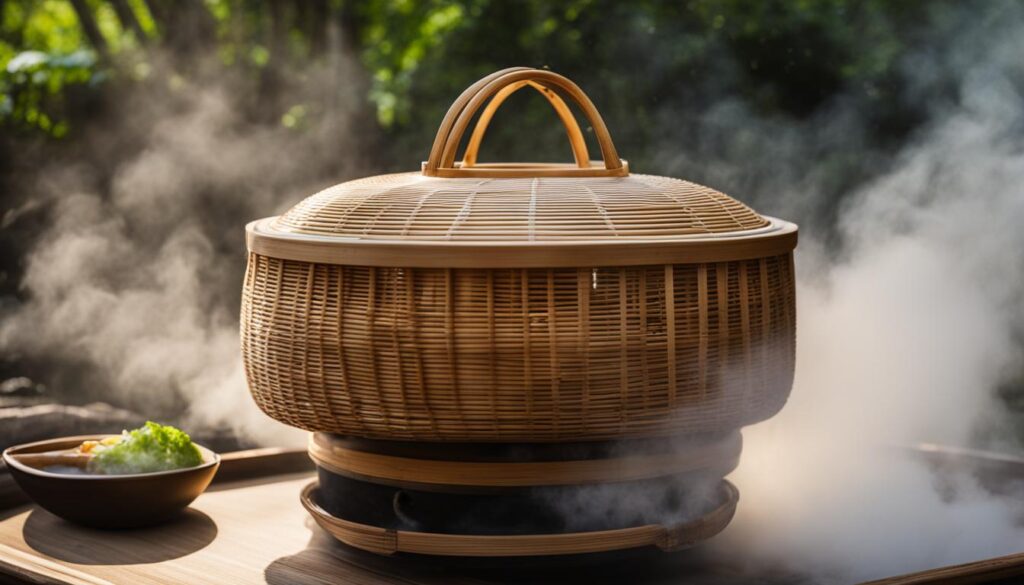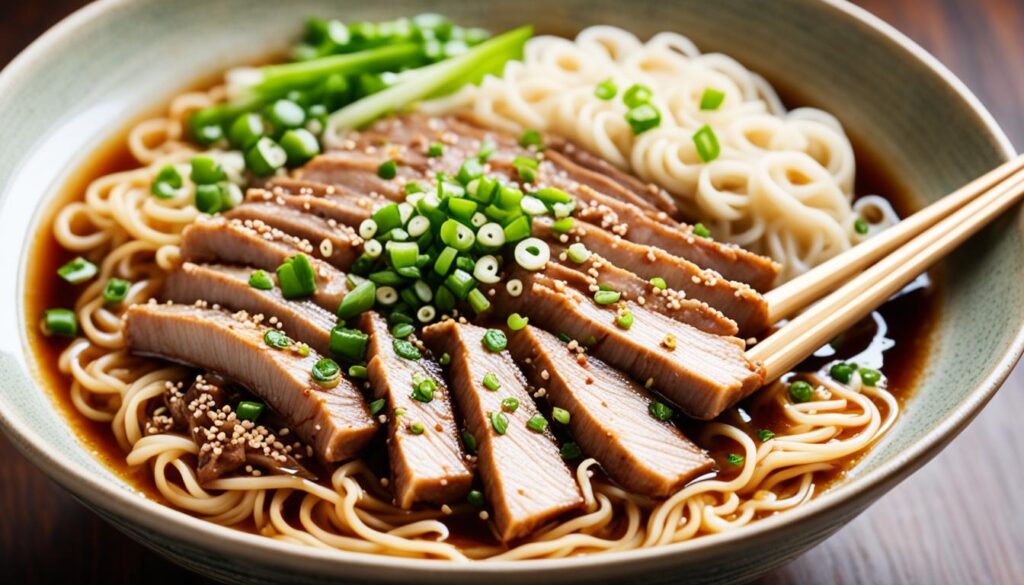
Japanese cuisine, known as Washoku, is revered for its artistry and simplicity. The flavors of traditional Japanese dishes are crafted to bring out the natural essence of each ingredient, resulting in a harmonious and delightful dining experience. If you’ve always wanted to delve into the world of cooking Japanese food, you’ve come to the right place. In this article, we will guide you through the techniques and recipes that will help you master the art of cooking Japanese food in the comfort of your own kitchen.
Key Takeaways:
- Japanese cuisine emphasizes simplicity and preserving the natural flavors of the ingredients.
- Mastering Japanese cooking techniques will enable you to recreate traditional Japanese dishes at home.
- Explore a variety of Japanese recipes to expand your culinary skills and repertoire.
- Understanding the importance of dashi, rice, soups, grilling, steaming, simmering, stir-frying, noodles, frying, and dressings is crucial to mastering Japanese cuisine.
- Experiment with these techniques and recipes to create authentic Japanese flavors in your own kitchen.
The Japanese Meal: Turning the Recipes into Dinner
In Japanese cuisine, a traditional meal consists of several components that come together to create a harmonious and balanced dining experience. These components include rice, soup, a main dish, and side dishes. By incorporating the recipes discussed in this article, you can create a complete Japanese meal that showcases the essence of traditional dishes.
Let’s take a closer look at each component:
Rice
Rice, or “gohan” in Japanese, forms the foundation of a Japanese meal. It is typically steamed and served alongside other dishes. The quality of the rice and the way it is cooked play a crucial role in the overall taste and texture of the meal.
Soup
Soup, known as “shiru” or “suupu” in Japanese, is a common accompaniment to a Japanese meal. Miso soup, made from fermented soybean paste, is a staple. It is light, flavorful, and often contains ingredients like tofu, seaweed, and vegetables.
Main Dish
The main dish, or “principal dish,” known as “shusai” in Japanese, is the centerpiece of the meal. It can be a protein-based dish such as grilled fish, braised meat, or tempura. The main dish is often seasoned with sauces like teriyaki or ponzu to enhance the flavors.
Side Dishes
Side dishes, or “okazu” in Japanese, complement the main dish and add variety to the meal. They can range from simple preparations of vegetables, pickles, and salads to more elaborate dishes like stir-fried vegetables or simmered tofu.
By combining these components, you can create a well-rounded Japanese meal that captures the essence of traditional dishes. The flavors, textures, and presentation of each dish contribute to the overall dining experience.
“A traditional Japanese meal is a celebration of flavors, textures, and balance. Each component plays a vital role in creating a harmonious dining experience that honors the traditions and techniques of Japanese cuisine.”
When planning your Japanese meal, it’s important to consider the balance of flavors, colors, and textures. Aim for a variety of tastes, such as sweet, salty, sour, and umami, to create a dynamic palate.
| Component | Examples |
|---|---|
| Rice | Steamed white rice, sushi rice |
| Soup | Miso soup, clear broth soup |
| Main Dish | Grilled salmon, teriyaki chicken |
| Side Dishes | Seaweed salad, pickled vegetables |
Remember to pay attention to the presentation of your meal, as aesthetics are highly regarded in Japanese cuisine. Take inspiration from traditional Japanese tableware and incorporate elements of nature, such as fresh flowers or bamboo mats, to create a visually pleasing dining experience.
Now that you understand the components and concepts behind a traditional Japanese meal, it’s time to dive into the recipes and techniques that will bring this culinary experience to life. Let’s explore the art of cooking traditional Japanese dishes in the upcoming sections.
Dashi: The Easy, Essential Japanese Stock
Dashi is a fundamental ingredient in Japanese cooking, essential for unlocking the authentic flavors of traditional Japanese dishes. As the base for many soups, sauces, and stews, mastering the art of making dashi is a crucial step in your Japanese culinary journey.
There are two common methods of preparing dashi: using dried fish and kelp, or kelp alone. The combination of these ingredients creates a rich umami flavor that forms the backbone of Japanese cuisine.
To make dashi using dried fish and kelp, follow these simple steps:
- Start by adding a piece of dried kombu (a type of seaweed) to a pot of cold water.
- Allow the kombu to soak for about 30 minutes, which helps extract its flavors.
- Slowly heat the water, bringing it to a simmer but not allowing it to boil. Remove the kombu just before the water reaches its boiling point.
- Add a handful of katsuobushi (dried fermented skipjack tuna flakes) to the pot and gently simmer for a few minutes.
- Strain the liquid through a fine-mesh sieve or cheesecloth to remove any impurities or solids.
- Your homemade dashi is now ready to be used in various Japanese recipes!
Here’s a quick recipe for making dashi with kelp alone:
- Place a piece of dried kombu in a pot filled with cold water.
- Allow the kombu to soak for at least 30 minutes, up to several hours for a stronger flavor.
- Gently heat the water, bringing it to a simmer, and continue simmering for about 10 minutes.
- Remove the kombu from the pot and discard.
- Strain the liquid to ensure a smooth and clear dashi.
Remember, dashi is the foundation of many Japanese dishes, including miso soup, noodle broths, and simmered dishes. By mastering the preparation of dashi, you’ll elevate the flavors of your homemade Japanese creations.
So why not give it a try? Prepare your own dashi and embark on a culinary adventure through the vibrant flavors of Japan!
Image: Dashi – the key to unlocking authentic flavors in Japanese cuisine.
Gohan: Rice
Rice, known as gohan in Japanese, is a staple in Japanese cuisine. It is the foundation of many traditional dishes and serves as a versatile accompaniment to a variety of flavors. To create the perfect bowl of white rice, follow these tips:
- Measure the rice and water accurately for the desired texture. The general rule is to use a 1:1 ratio of rice to water for sticky rice and a 1:1.5 ratio for fluffy rice.
- Wash the rice thoroughly to remove excess starch. Place the rice in a bowl, fill it with water, and gently scrub the grains together with your hands. Rinse and repeat until the water becomes clear.
- Let the rice soak for 30 minutes before cooking. This step helps the grains cook evenly and absorb water more effectively.
- Use a heavy-bottomed pot with a tight-fitting lid to cook the rice. Bring the rice and water to a boil, then reduce the heat to low and simmer for about 15-20 minutes.
- After cooking, let the rice rest for 10 minutes off the heat to finish steaming. This allows the moisture to redistribute and the grains to become tender and fluffy.
Gohan is not only enjoyed as plain steamed rice but also in various flavorful dishes. Here are some popular rice-based dishes in Japanese cuisine:
| Dish | Description |
|---|---|
| Onigiri | Rice balls filled with savory ingredients and often wrapped in seaweed. They make a convenient and satisfying snack. |
| Yaki Onigiri | Grilled rice balls that are crispy on the outside and soft on the inside, usually brushed with soy sauce or miso before grilling. |
| Chahan | Japanese-style fried rice cooked with various ingredients such as vegetables, meat, and seafood. It is a flavorful and satisfying one-pot dish. |
| Sushi Rice | The seasoned rice used as the base for sushi rolls and nigiri. It is typically flavored with rice vinegar, sugar, and salt. |
Whether enjoyed as a simple side or as the star of a dish, rice plays a central role in Japanese cuisine. Experiment with different rice varieties and dishes to discover the diverse flavors and textures that gohan brings to your meals.
Supu: Soups
Soups play a significant role in Japanese cuisine, with miso soup being a staple. Miso soup is a flavorful and comforting dish that is often enjoyed as part of a traditional Japanese meal. Made with fermented soybean paste, or miso, it is a versatile soup that can be customized with various ingredients.
If you’re a fan of tofu, you’ll love miso soup with tofu. The soft and delicate texture of tofu pairs perfectly with the umami-rich miso broth. For seafood lovers, miso soup with clams is a delightful option. The combination of briny clams and savory miso creates a harmonious flavor profile.
For a heartier soup, try hearty miso soup with pork and vegetables. This version features tender slices of pork, crisp vegetables, and warming spices. It’s a satisfying and nutritious meal on its own.
If you’re looking for something different, Japanese egg drop soup is worth a try. It’s a simple yet delicious soup made with a savory broth and gently cooked eggs. The silky ribbons of egg add texture and flavor to the soup.
Finally, chicken and dumpling soup is a comforting and filling option. The tender chicken, flavorful broth, and delicate dumplings make this soup a winner for any occasion.
Japanese Soup Recipes
| Soup | Key Ingredients |
|---|---|
| Miso soup with tofu | Tofu, miso paste, seaweed |
| Miso soup with clams | Clams, miso paste, green onions |
| Hearty miso soup with pork and vegetables | Pork, assorted vegetables, miso paste |
| Japanese egg drop soup | Chicken broth, eggs, green onions |
| Chicken and dumpling soup | Chicken, dumplings, vegetables |
Whether you’re seeking a light and refreshing soup or a heartier option, these Japanese soup recipes are sure to satisfy your cravings. They showcase the diverse flavors and versatility of Japanese cuisine. Don’t be afraid to experiment with different ingredients and flavors to create your own unique soup creations.
Yaku: To Grill, Boil, and Sear
In Japanese cuisine, mastering the art of grilling, boiling, and searing is essential to unleash the vibrant flavors of traditional dishes. These cooking techniques bring out unique textures and aromas, creating a delightful dining experience. Let’s explore some popular Japanese grilling and cooking techniques that will elevate your culinary skills.
Grilling Chicken and Vegetable Skewers
One classic dish that showcases the art of Japanese grilling is yakitori, which consists of skewered grilled chicken and vegetables. To prepare this flavorful dish, marinate bite-sized pieces of chicken in a sauce made from soy sauce, mirin, and sake. Thread the chicken onto skewers, along with vegetables like green bell peppers, onions, and shiitake mushrooms. Grill the skewers over charcoal or a gas grill until the chicken is cooked through and slightly charred. Serve these succulent skewers with a sprinkle of sesame seeds and a side of steamed rice.
Making Chicken Meatballs with Teriyaki Sauce
Another delicious way to incorporate Japanese grilling techniques is by preparing chicken meatballs, known as tsukune. Mix ground chicken with grated onion, breadcrumbs, egg, and seasonings. Shape the mixture into small meatballs and skewer them. Grill the meatballs until they are perfectly cooked and juicy. To add a tantalizing glaze, brush teriyaki sauce onto the meatballs during the last few minutes of grilling. Garnish with chopped scallions and enjoy these savory bites as an appetizer or paired with rice.
Salt-Grilling Salmon
Salt-grilling, or shioyaki, is a simple and flavorful technique commonly used for fish in Japanese cuisine. To salt-grill salmon, generously sprinkle kosher salt on both sides of the fish fillets. Allow the salt to sit for about 30 minutes to draw out excess moisture. Pat the fillets dry and grill them skin-side down until the flesh is opaque and flakes easily. The salt crust locks in the moisture, resulting in tender salmon with a delicate saltiness. Serve the salt-grilled salmon with grated daikon radish and a squeeze of fresh lemon juice for a refreshing twist.
Preparing Various Grilled Fish and Meat Dishes
In addition to chicken and salmon, Japanese grilling techniques can be applied to a wide range of fish and meat. For fish lovers, try grilling mackerel, yellowtail, or black cod to perfection. These fish are rich in flavors and become beautifully charred on the grill. If you prefer meat, indulge in succulent beef or pork cuts like ribeye, tenderloin, or thinly sliced pork belly, which can be marinated for extra depth of taste. Experiment with different seasonings such as miso, soy sauce, ginger, or garlic to create unique flavor profiles. Pair your grilled fish or meat dishes with a refreshing side salad or pickles for a well-balanced meal.
| Japanese Grilling Techniques | Description |
|---|---|
| Yakitori | Skewered grilled chicken and vegetables, often served as a snack or appetizer. |
| Tsukune | Chicken meatballs grilled and glazed with teriyaki sauce, bursting with savory flavors. |
| Shioyaki | Salt-grilled fish, particularly salmon, known for its delicate flavor and tender texture. |
| Various Grilled Fish and Meat | Grilled fish and meat dishes, ranging from mackerel and black cod to beef or pork cuts. |
With these Japanese grilling techniques, you can elevate your culinary skills and create mouthwatering dishes bursting with authentic flavors. Whether you’re grilling chicken and vegetable skewers, making chicken meatballs with teriyaki sauce, salt-grilling salmon, or preparing various grilled fish and meat dishes, these techniques will impress your family and friends. Embrace the art of Japanese grilling and enjoy the delicious results!
Musu: To Steam
Steaming is a traditional Japanese cooking method that allows you to create flavorful and healthy dishes. By using this gentle technique, you can preserve the natural flavors and textures of the ingredients, resulting in delicious meals. In this section, we will introduce you to some popular steamed dishes in Japanese cuisine.
Fish Steamed in Kombu with Spicy Soy Sauce
One classic dish that showcases the art of Japanese steaming is fish steamed in kombu with spicy soy sauce. The kombu, a type of kelp, imparts a subtle umami flavor to the fish, while the spicy soy sauce adds a kick to every bite. This dish is perfect for seafood lovers looking to experience the delicate flavors of steamed fish.
Japanese-Style Shrimp Dumplings
Another delicious steamed dish is Japanese-style shrimp dumplings. Made with a combination of succulent shrimp, crunchy vegetables, and fragrant seasonings, these dumplings are delicate yet packed with flavors. The steaming process ensures that they retain their juiciness while cooking to perfection.
Egg Custard with Shrimp, Chicken, and Fish
For a more intricate steamed dish, try the egg custard with shrimp, chicken, and fish. This savory custard is made by gently steaming a mixture of beaten eggs, dashi stock, and a medley of seafood and poultry. The result is a silky and comforting dish with layers of flavors.
Explore the world of Japanese steamed dishes and unlock new culinary experiences in your own kitchen. The gentle and health-conscious nature of steaming allows you to appreciate the natural essence of the ingredients. Impress your family and friends with these delectable steamed dishes that are sure to leave a lasting impression.

Niru: To Simmer
Simmering is a gentle cooking technique in Japanese cuisine that allows ingredients to slowly cook in liquid, resulting in dishes with rich and developed flavors. By mastering the art of simmering, you can create delicious and comforting simmered dishes that showcase the essence of Japanese cuisine.
Here are some recipes for simmered dishes that you can try at home:
Mackerel Simmered with Miso
This dish features succulent mackerel fillets simmered in a flavorful miso-based sauce. The umami-rich miso complements the natural richness of the fish, resulting in a satisfying and hearty dish.
Fish Simmered with Sake, Soy Sauce, and Sugar
This recipe combines the flavors of sake, soy sauce, and sugar to create a sweet and savory broth in which fish is gently simmered. The resulting dish is delicate and aromatic, with the fish soaking up the delicious flavors of the broth.
Chicken Simmered with Lotus Root and Bamboo Shoot
This dish brings together tender chicken, crunchy lotus root, and bamboo shoot in a simmering broth. The combination of textures and flavors creates a well-balanced and comforting dish that pairs perfectly with steamed rice.
Simmered dishes are not only delicious but also versatile. They can be enjoyed as a main course or as a side dish to complement a Japanese meal. The slow cooking process allows the flavors to meld together, resulting in dishes that are truly satisfying.
So why not try your hand at simmering and elevate your Japanese cooking skills? With these recipes, you’ll be able to create authentic simmered dishes that capture the essence of Japanese cuisine.
Continue reading to discover more traditional Japanese cooking techniques!
Itame Ru: To Stir-Fry
Stir-frying, known as “itame ru” in Japanese, is a quick and flavorful cooking technique that can be used to create a variety of delicious dishes. By applying high heat and constantly stirring the ingredients, you can achieve a perfect balance of flavors and textures in your stir-fry dishes.
Stir-Fried Parsnip and Carrot
Looking to add some vibrant colors and earthy flavors to your stir-fry repertoire? Try this recipe for stir-fried parsnip and carrot. The natural sweetness of the parsnip and carrot pairs beautifully with the savory seasonings, creating a satisfying and nutritious dish.
Vegetable Stir-Fry
If you’re looking for a versatile and customizable stir-fry dish, a vegetable stir-fry is the perfect choice. You can use an assortment of your favorite vegetables, such as bell peppers, broccoli, snow peas, and mushrooms, to create a colorful and wholesome meal. Add some protein like tofu or shrimp to make it even more filling.
Udon Noodles with Seafood
For a hearty and satisfying stir-fry dish, try udon noodles with seafood. The thick and chewy udon noodles pair perfectly with the tender seafood, creating a harmonious blend of flavors. Customize it by adding your favorite vegetables and seasonings to make it your own.
Yakisoba with Pork, Cabbage, and Ginger
Yakisoba, a popular Japanese street food dish, is a delicious stir-fry made with wheat noodles, pork, cabbage, and ginger. The combination of salty, sweet, and tangy flavors makes it an absolute crowd-pleaser. Give it a try and transport yourself to the bustling streets of Japan.
With these stir-fry recipes, you can explore the vibrant world of Japanese stir-frying and create delicious meals bursting with flavors. Whether you’re a fan of colorful vegetables, seafood, or hearty noodles, there’s a stir-fry dish for everyone to enjoy. So grab your wok and start stir-frying your way to culinary perfection!
Men: Noodles
Noodles are a beloved and versatile ingredient in Japanese cuisine. From soba to udon, Japanese noodles come in various shapes and sizes, each offering a unique texture and flavor. In this section, we will explore different noodle dishes that showcase the diversity and deliciousness of Japanese noodles.
Chilled Soba Noodles with Mushrooms
If you’re looking for a refreshing and light noodle dish, try chilled soba noodles with mushrooms. This dish combines the earthy flavors of mushrooms with the nuttiness of soba noodles. Simply cook the noodles according to the package instructions, then chill them in ice water. Toss the noodles with sautéed mushrooms and a drizzle of soy sauce for a simple yet flavorful meal.
Soba Noodle Soup with Duck and Spring Vegetables
For a heartier option, indulge in soba noodle soup with duck and spring vegetables. This comforting dish features tender duck meat, seasonal crisp vegetables, and toothsome soba noodles in a savory broth. It’s perfect for warming up on chilly days or when you crave a satisfying bowl of noodles.
Udon Noodles with Scallions and Ginger
If you prefer thick and chewy noodles, udon is the way to go. A classic udon dish is udon noodles with scallions and ginger. This simple yet flavorful combination showcases the natural umami of udon noodles, enhanced by the aromatic tang of scallions and ginger. It’s a quick and easy dish that can be enjoyed on its own or as a side to complement other Japanese favorites.
Whether you prefer your noodles chilled or in a comforting bowl of soup, Japanese cuisine offers a wide variety of noodle dishes to satisfy your cravings. The next time you’re in the mood for a taste of Japan, try one of these delightful noodle recipes and discover the wonders of Japanese noodles.

Ageru: To Fry
Frying, or “ageru” in Japanese, is a cooking technique that produces crispy and delicious results. It is a popular method used in Japanese cuisine to create a wide variety of fried dishes. Whether it’s light and crispy vegetable tempura, savory shrimp and vegetable fritters, succulent Japanese-style fried chicken with scallion sauce, or the beloved fried pork cutlet, the art of Japanese frying brings a delightful crunch to your plate.
One of the key aspects of Japanese frying is the meticulous preparation of ingredients and the precise control of temperature and cooking time. This ensures that the dish achieves the perfect balance of crispiness on the outside while maintaining a juicy and flavorful interior.
When it comes to frying in Japanese cuisine, two common methods are often used: karaage and tempura. While karaage refers to the technique of marinating and deep-frying bite-sized pieces of meat, typically chicken, tempura involves coating various ingredients, such as seafood, vegetables, or even ice cream, in a light batter before frying them to golden perfection.
A Selection of Japanese Fried Dishes
| Dish | Description |
|---|---|
| Vegetable Tempura | A delightful assortment of lightly battered and fried vegetables, such as sweet potatoes, eggplant, and bell peppers. |
| Shrimp and Vegetable Fritters | Crispy fritters made with tender shrimp and a medley of vegetables, such as zucchini and onions. |
| Japanese-style Fried Chicken with Scallion Sauce | Tender pieces of chicken marinated in a savory soy-based sauce and fried until golden brown, served with a tangy scallion sauce. |
| Fried Pork Cutlet (Tonkatsu) | A popular Japanese dish consisting of breaded and deep-fried pork cutlets, typically served with shredded cabbage and a rich tonkatsu sauce. |
Whether you’re enjoying a delicate piece of tempura or savoring the flavorful crunch of karaage, Japanese frying is a technique that adds texture and depth of flavor to a wide range of dishes. It is an art form that requires precision and attention to detail to achieve the perfect balance of crispy deliciousness. So, the next time you feel like indulging in some fried goodness, explore the world of Japanese frying and elevate your culinary skills.
Ae Ru: To Dress
Dressings are an essential element of Japanese cuisine, elevating flavors and enhancing the overall dining experience. Japanese dressings are known for their harmonious blend of ingredients that create a perfect balance of flavors. In this section, we will provide you with recipes for Japanese dressings that will bring a delightful twist to your dishes.
Green Beans with Sesame Dressing
Enjoy the vibrant flavors of green beans with a nutty and tangy sesame dressing. This dressing combines the richness of toasted sesame seeds with the freshness of citrus to create a tantalizing balance of flavors. The creamy texture of the dressing is the perfect complement to the tender-crisp green beans.
Brussels Sprouts, Shrimp, and Mushrooms with Japanese Mustard Dressing
Indulge in a mouthwatering combination of Brussels sprouts, succulent shrimp, and earthy mushrooms, all brought together by a zesty Japanese mustard dressing. This dressing adds a delightful kick to the dish, enhancing the natural flavors of the ingredients and creating a satisfying meal.
Spinach, Carrot, and Shiitake with Tofu Dressing
Experience the delicate flavors of sautéed spinach, sweet carrot, and umami-rich shiitake mushrooms, enhanced by a creamy and tangy tofu dressing. The dressing adds a velvety texture and a subtle tang that beautifully complements the vegetables, elevating them to new levels of deliciousness.
Squid and Scallions with Miso-Vinegar Dressing
Delight your taste buds with a combination of tender squid, flavorful scallions, and a miso-vinegar dressing that adds a delightful punch of umami. The dressing brings out the natural sweetness of the squid, while the tangy notes from the vinegar create a wonderful harmony of flavors.
These Japanese dressings will take your dishes to new heights, infusing them with unique flavors and adding a touch of authenticity to your culinary creations. Try these recipes and explore the world of Japanese dressings, elevating your dressing dishes to a whole new level.
Conclusion
By mastering the Japanese cooking techniques discussed in this article, you can confidently cook Japanese food at home. From traditional dishes like sushi rice to flavorful soups and grilled foods, you can unleash the flavors of Japan in your own kitchen.
Experiment with these techniques and recipes to create authentic Japanese cuisine at home. Whether you’re simmering ingredients to develop rich flavors, stir-frying for a quick and delicious meal, or grilling to bring out the natural smokiness, the art of Japanese cooking offers a wide range of possibilities for your culinary journey.
With an understanding of the basics like making dashi for a flavorful stock and perfecting the art of cooking Japanese rice, you’ll be well on your way to creating a traditional Japanese meal. Additionally, don’t forget to explore the variety of noodles and dressings that add depth and excitement to your dishes.
So, put on your apron and embark on an adventure into the world of Japanese cuisine. With dedication and practice, you’ll soon be delighting your taste buds with authentic flavors and impressing your friends and family with your newfound culinary skills.







